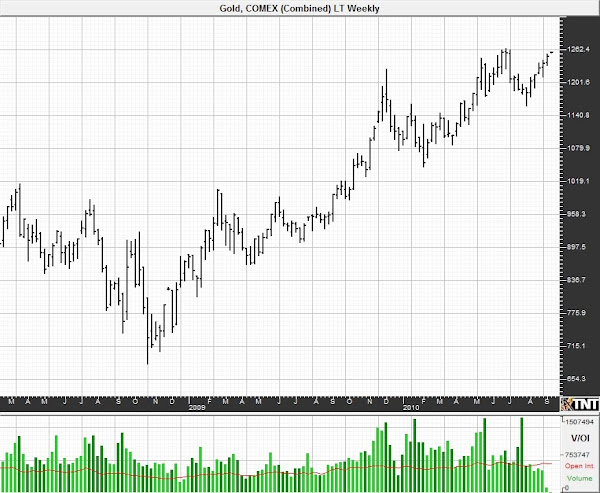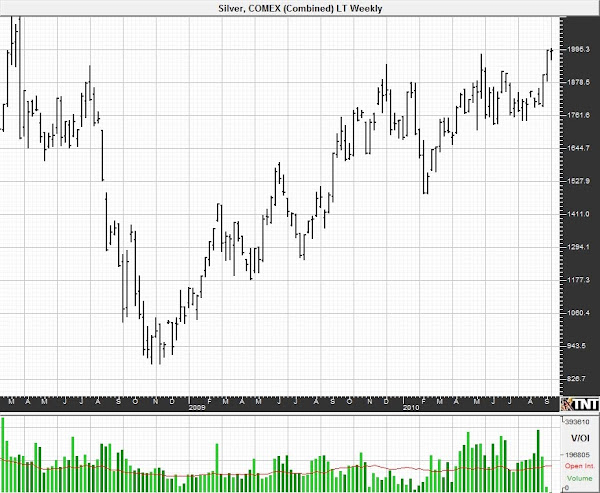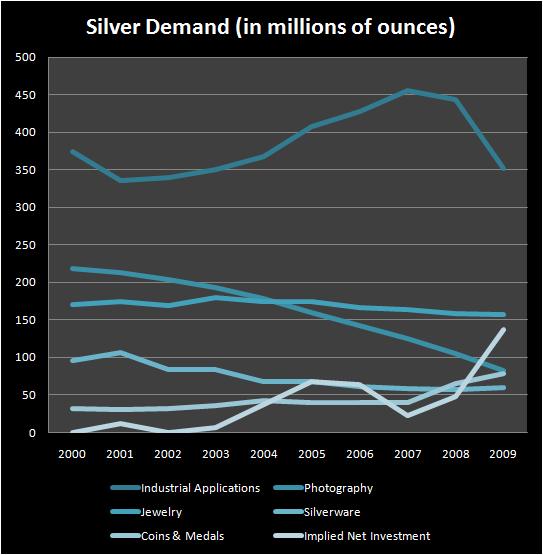traderkenny
Active member
- Messages
- 106
- Likes
- 4
Precious metals often find themselves sharing a stage, being analyzed through blanket statements about investment demand, inflation, and other fundamental concerns. However, there are also moments when silver gets singled out. It is sometimes lauded as being undervalued and poised for explosive interest and gains. Other moments may find it being treated like the ugly step-child and viewed as a tailcoat rider, ready to be dropped at a moment of weakness. Before jumping to any conclusions about the true relationship between gold and silver, let’s take a look at the beating heart for each.

Past performance is not indicative of future results.
***chart courtesy Gecko Software’s Track n’ Trade Pro

Past performance is not indicative of future results.
***chart courtesy Gecko Software’s Track n’ Trade Pro
The Breakdown
There are three key components to both gold and silver market demand; jewelry, investment, and industrial. On the supply side, the main shared concerns are the mining production and the resale and reuse of existing above ground supplies. Now, all of these similarities are in title only. The actual state of supply and demand for each of these metals can be very different.
Talk of modern gold mining will normally conjure up an image of South Africa, one of the largest current gold mining areas. Silver is linked to South America, primarily Peru. In recent years, this production from mines contributed 75 percent of silver supplies and 59 percent of gold supplies. At a glance, this might suggest that where prolonged mining concerns like strikes or power outages rear their heads, the impact on silver production may be felt deeper than the same for gold. Of course, this kind of information would have to be weighed against the existing supplies.
The above ground supplies for each metal would probably suggest that silver supplies surpass gold. After all, gold’s place as a precious store of wealth was often attributed to its rarity and one of the common bimetal ratios applied to silver and gold is 15 or 16 ounces of silver to one ounce of gold. That is, one ounce of gold could be purchased for 15 or 16 times more silver. The total identifiable above ground stock of silver according to the GFMS was around 700 million ounces, while other outlets suggest nearly 2.2 billion ounces. Estimates for all the gold ever mined run around 140,000 tons. Either way, this could put gold ahead of silver in quantity. The possible catalyst for this difference is that silver mines and their output have not been meeting the consumption demands for silver. This has suggested to some analysts that silver is operating with a diminishing supply situation. So what about demand?
Applications for each metal cross from jewelry and investment vehicles to electronic and consumer devices. The main difference, of course, is that gold is more heavily in demand for the former while silver rules the roost in the latter. According to the World Gold Council, the demand for gold as ornament and investment claims over 80 percent of the demand pie. Dentistry absorbs another 2 percent and the remaining gold is used for electronics and other industrial applications. Normally, this involves electroplating other base metals to make components for electronics.
Silver’s demand landscape leans more towards the industrial applications in the last decade. Investment has grown recently on the back of the economic crisis, but overall remains lower on the scale. Photography obviously held a lion’s share of the consumption of silver prior to the dawn of digital age, but the failings of that sector were met with the increased need for electronic components for everything from cell phones to smaller, more luxurious personal electronic devices. Silver has exceptional electrical conduction properties which means these commercial applications will probably recoup losses if the economy picks up. This kind of demand, especially for consumer goods which are in continuous use, is not as easily recoverable as other gold and silver applications.

Data courtesy of The Silver Institute
Summary
The short story for both metals is that they are desirable both as a store of wealth in the face of financial crisis and as marketable components in the industrial sector. Silver has thus far failed to breech its highs while gold prices have been made fresh ones. Silver prices have remained at the potential mercy of the health of the economy. The possibility of a rebound in the manufacturing sector could help drive prices higher if it materializes. Otherwise, the gains in silver price on the back of gold price could theoretically remain flimsy. If the argument for investing in silver is the aforementioned diminishing supply situation, than a slow or failed recovery of the global economy could deal that argument a blow. What is comes down to is this: A bullish world stage to bring support to silver prices and help them gain and hold their ground. Otherwise, gold will prevail and silver will remain ever the bridesmaid.
Hunger for gold is made greater as more gold is acquired. - AURELIUS CLEMENS PRUDENTIUS, Hamartigenia

Past performance is not indicative of future results.
***chart courtesy Gecko Software’s Track n’ Trade Pro

Past performance is not indicative of future results.
***chart courtesy Gecko Software’s Track n’ Trade Pro
The Breakdown
There are three key components to both gold and silver market demand; jewelry, investment, and industrial. On the supply side, the main shared concerns are the mining production and the resale and reuse of existing above ground supplies. Now, all of these similarities are in title only. The actual state of supply and demand for each of these metals can be very different.
Talk of modern gold mining will normally conjure up an image of South Africa, one of the largest current gold mining areas. Silver is linked to South America, primarily Peru. In recent years, this production from mines contributed 75 percent of silver supplies and 59 percent of gold supplies. At a glance, this might suggest that where prolonged mining concerns like strikes or power outages rear their heads, the impact on silver production may be felt deeper than the same for gold. Of course, this kind of information would have to be weighed against the existing supplies.
The above ground supplies for each metal would probably suggest that silver supplies surpass gold. After all, gold’s place as a precious store of wealth was often attributed to its rarity and one of the common bimetal ratios applied to silver and gold is 15 or 16 ounces of silver to one ounce of gold. That is, one ounce of gold could be purchased for 15 or 16 times more silver. The total identifiable above ground stock of silver according to the GFMS was around 700 million ounces, while other outlets suggest nearly 2.2 billion ounces. Estimates for all the gold ever mined run around 140,000 tons. Either way, this could put gold ahead of silver in quantity. The possible catalyst for this difference is that silver mines and their output have not been meeting the consumption demands for silver. This has suggested to some analysts that silver is operating with a diminishing supply situation. So what about demand?
Applications for each metal cross from jewelry and investment vehicles to electronic and consumer devices. The main difference, of course, is that gold is more heavily in demand for the former while silver rules the roost in the latter. According to the World Gold Council, the demand for gold as ornament and investment claims over 80 percent of the demand pie. Dentistry absorbs another 2 percent and the remaining gold is used for electronics and other industrial applications. Normally, this involves electroplating other base metals to make components for electronics.
Silver’s demand landscape leans more towards the industrial applications in the last decade. Investment has grown recently on the back of the economic crisis, but overall remains lower on the scale. Photography obviously held a lion’s share of the consumption of silver prior to the dawn of digital age, but the failings of that sector were met with the increased need for electronic components for everything from cell phones to smaller, more luxurious personal electronic devices. Silver has exceptional electrical conduction properties which means these commercial applications will probably recoup losses if the economy picks up. This kind of demand, especially for consumer goods which are in continuous use, is not as easily recoverable as other gold and silver applications.

Data courtesy of The Silver Institute
Summary
The short story for both metals is that they are desirable both as a store of wealth in the face of financial crisis and as marketable components in the industrial sector. Silver has thus far failed to breech its highs while gold prices have been made fresh ones. Silver prices have remained at the potential mercy of the health of the economy. The possibility of a rebound in the manufacturing sector could help drive prices higher if it materializes. Otherwise, the gains in silver price on the back of gold price could theoretically remain flimsy. If the argument for investing in silver is the aforementioned diminishing supply situation, than a slow or failed recovery of the global economy could deal that argument a blow. What is comes down to is this: A bullish world stage to bring support to silver prices and help them gain and hold their ground. Otherwise, gold will prevail and silver will remain ever the bridesmaid.
Hunger for gold is made greater as more gold is acquired. - AURELIUS CLEMENS PRUDENTIUS, Hamartigenia
